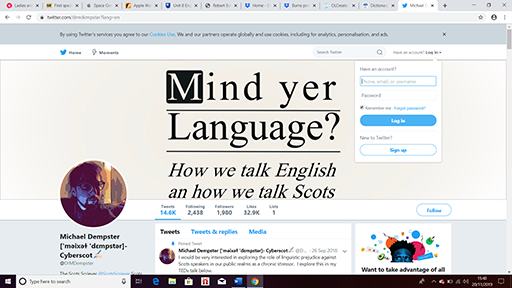20.5 A Standard Scots continued

Whilst some may ask: “Can there be a Standard Scots?” enquiring if it is possible to define one, it has already been demonstrated that there can be. The question that remains to be answered is, ‘Which standard will there be?’
One consideration when answering this question may be that a standard ought to come from a prestige dialect. There have been a number of the dialects with stronger identities that have sought to define themselves quite fervently and these dialects may be candidates for being ‘prestige dialects’. But, again, we face the challenge of defining for example a standard Doric, a standard Shetland, a standard Ayrshire, or a standard Borders.
Below you will find a list of publications establishing dialectical standards in the Scots language with some leaning more towards novelty books than functional dialectical standards. Yet all are provide insights into particular varieties of Scots.
- 1866 – An Etymological Dictionary of the Shetland and Orkney Dialect, Thomas Edmunston
- 1914 – A Glossary of the Shetland Dialect, James Stout Angus
- 1915 – Lowland Scotch as Spoken in the Lower Strathearn District of Perthshire, James Wilson
- 1979 – The Shetland Dictionary, John J Graham
- 1990 – Teach Yourself Doric, Douglas Kynoch
- 1990 – Dundonian for Beginners, MickMcClusky
- 1996 – The Complete Patter, Michael Munro
- 1996 – Doric Dictionary, Douglas Kynoch
- 2007 – Ulster Scots, Philip Robinson
- 2009 – Spikkin Doric, Norman Harper
- 2013 – A Hawick Word Book, Douglas Scott
A concern amongst those who speak those dialects mentioned in the publications above, is that the dialects of Scots with less strong identities, but much larger populations, such as the urban dialects, will prevail as a standard. Indeed, the worry is that any standard form of Scots is a threat to their dialect as much as standard English has been to Scots. This is a valid concern – yet an example that shows that efforts are being made to give parity to dialect versions of Scots are recent publications of multiple versions of The Gruffalo and Alice in Wonderland in different Scots dialects. Developments like these allow for a better reflection of dialect speakers’ language in literature written in Scots.
Since the 1920s and increasingly in the internet age, a number of pan-dialectical grammars have been published which encapsulate Scots with a variety of priorities, some of these publications you have come across in Unit 17 of this course.
- 1921 – Manual of Modern Scots, William Grant & James Main Dixon
- 1947 – The Scots Style Sheet, The Makkars' Club
- 1979 – Recommendations for Writers in Scots, Scots Language Society
- 1996 – Mensfu Scots Spellin, Scots Spellin Comatee 1996-1998*
- 1997 – A Scots Grammar, David Purves
- 1997 – Wir Ain Tung, Andy Eagle*
- 1999 – Grammar Broonie, Susan Rennie (with additional material by Matthew Fitt)
- 2002 – Luath Scots Learner, L Colin Wilson
- 2009 – Scots language Wikipedia style guide*
- 2012 – Modren Scots Grammar, Christine Robinson
- 2013 – The Scots Learners' Grammar, Clive P L Young*
- 2014 – Aw Ae Wey, Andy Eagle*
- 2014 – Mind yer Language, Michael Dempster*
- 2016 – An Introduction to Modern Scots, Andy Eagle*
- 2017 – Mak Forrit Stylesheet, Jamie Smith*
- *self-published and available online.
In the publications of this list above, the Style Sheets and the Scots Spelling Comatee's recommendations aim at regularising literary Scots. Andy Eagle in his publications looks for a pan-dialectical written standard, moving away from phonological representation of phonetic spelling. Colin Wilson’s objective is to introduce Scots to new learners. Susan Rennie and Christine Robinson look to provide accessible grammars for children and adults seeking to become literate in Scots. Michael Dempster’s work looks to teach speakers, singers and performers how to understand written Scots' connection to spoken Scots as it is across dialects and historical periods.
The author of this unit’s own preference is for a Standard Written Scots that can capture as much as is spoken today, particularly with grammatical veracity. Others want a single standard of prescriptive spelling that all can work to. Some believe ease of learning ought to be a priority when developing a standard for Scots. Others still feel that in the language shift towards a standard historical reconstruction ought to be a priority.
The list of criticisms often expressed about use of Scots is long, for example people criticise the use of others’ spelling agreement, or words being used that are not considered contemporary or from a speaker's dialect area, or English grammar standards superseding Scots ones in language use. However, these are all criticisms which can be hurled at any standard language. And once one takes the time to consciously address each of these issues, it becomes clear that they are far from insurmountable and rarely as big an issue as they seem. And … all of these things are teachable.
What has been absent until recently in the wider Scots community is the will to teach or learn a standard. It is likely that from those publications listed above a perfectly functional standard can be reached. Regardless of such publications, due to the possibilities for digital self-publishing and a massive new body of Scots examples and innovations, even a single text or tweet, new conventions are emerging, such as the spelling of the English ‘cannot’ in Scots as canny (previously cannae), the English ‘going to’ in Scots as gonny (previously gonnae), or the English ‘have to’ in Scots as huvty (previously huv tae).
This emergent usage represents a written connection to hundreds of years of Scottish culture. Yet this connection does not always seem to be immediately evident to those who have the desire to express themselves in their language, Scots. They sometimes struggle to know how to connect to this wealth of Scots literature. This is where we come full circle and where institutions that house collections of Scots in spoken and written form continue to reach and have an impact on Scots speakers, its writers and readers.
Activity 12
To conclude your study of this section, you will again test your translation skills and apply what you have learned here by translating the Scots instructions below into Standard English. In these instructions we have purposefully used a mix of Scots vocabulary and spellings which you have come across in various units of this course.
This time try not to reach for the DSL immediately when you are not sure about the meaning of a word. Try reading out loud the instructions first of all, which can help you understand the word, even though you might not be familiar with its particular spelling here.
“Yer gonnae huvty git oan yon bus – thae een, at’s heidin sooth – if ye ir gonny hae ony hope o makkin it doon the links afore fower a clock...”
Answer
This is our suggested translation of the Scots instructions. Your translation might be different.
“You are going to have to get on that bus – that one, that’s heading south – if you are going to have any hope of making it down to the golf course before four o clock.”
20.4 A Standard Scots
